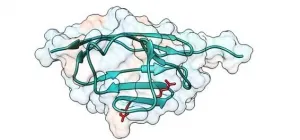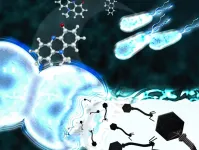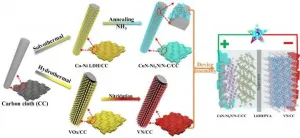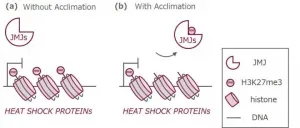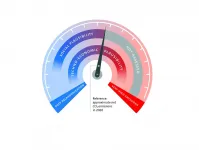INFORMATION:
The study was funded by the Ministerio de Ciencia e Innovación, the European Research Area Network on Cardiovascular Diseases (MINOTAUR consortium, through the Instituto de Salud Carlos III), the Comunidad de Madrid, the US National Institutes of Health, the government of the Basque region, the Italian Ministry of Education, Universities and Research, and postdoctoral fellowships from the School of Medicine and the Maternal and Child Health Institute at Stanford University.
The research team also included scientists from the Cardiovascular Biomedical Research Network (CIBERCV).
ACS Nano: CNIC scientists describe a possible disease-causing mechanism in hypertrophic cardiomyopathy
2021-06-10
(Press-News.org) Scientists at the Centro Nacional de Investigaciones Cardiovasculares (CNIC) have described a potential disease-causing mechanism in hypertrophic cardiomyopathy (HCM), the most frequent hereditary disease of the heart. The study, published in the journal ACS Nano, provides the first description of an association between this disease and mechanical alterations to a component of the contractile machinery of the heart.
The heart muscle is under constant mechanical stress throughout life as it contracts to pump blood to the body. The laboratory led by Dr. Jorge Alegre-Cebollada investigates how the mechanical properties of the cardiac proteins determine the physiological behavior of this muscle and how alterations to these properties lead to the appearance of diseases like HCM. In this disease, the most frequent hereditary disease affecting the heart, the left ventricle becomes enlarged, and severe manifestations include heart failure and sudden death.
Scientists have known for more than 20 years that HCM is caused by mutations in proteins with a mechanical function in the heart. One of the challenges of cardiovascular genetics is to identify which among the genetic variants found in patients and their families cause disease. Knowing if a mutation is disease-causing or not is important because this information will determine the clinical follow-up of family members and, potentially, their treatment.
The new study, coordinated by Dr. Jorge Alegre-Cebollada, analyzed cardiac myosin-binding protein C (cMyBP-C).
First author Carmen Suay-Corredera explained that cMyBP-C, which regulates heart contraction, is the most frequently mutated protein in HCM patients. "A high proportion of mutations in the cMyBP-C gene cause amino-acid changes in the protein; however, the mechanisms by which these mutations cause HCM are not precisely known."
Dr. Alegre-Cebollada's group, in close partnership with clinical and molecular researchers in Europe and the US, set up a database of cMyBP-C variants with a clear link to HCM in order to define the molecular defects underlying the disease.
Using bioinformatics and experimental approaches, the research team discovered that around half of these mutations affect the integrity of cMyBP-C messenger RNA (mRNA) or protein. These results have already been accepted for publication in the Journal of Biological Chemistry and have been the subject of a commentary article in the leading medical genetics journal Genetics in Medicine.
While alterations to mRNA or protein integrity could explain the pathogenicity of half the mutations analyzed in the earlier study, Suay-Carredera pointed out that the other half do not cause disease via this route.
"It is precisely these variants, which cause HCM through unknown mechanisms, that we analyzed in the new study," explained Dr. Alegre-Cebollada, who leads the Molecular Mechanics of the Cardiovascular System group at the CNIC.
Using advanced biophysical techniques based on atomic force microscopy, the team showed that some of the disease-causing mutations in cMyBP-C produce defects in the mechanical properties of the protein that can alter the contractile function of cardiomyocytes in HCM patients.
"We are now investigating the disease-causing mechanisms of those variants that have not been linked to any relevant alteration in previous studies," said Dr. Alegre-Cebollada. For this project, the scientists are working with a range of experimental systems, from molecular systems to animal models of HCM.
Identifying the molecular mechanisms underlying HCM is essential for determining which cMyBP-C mutations cause the disease. This knowledge is therefore also crucial for the clinical follow-up and possible treatment of patients and their families, say the authors.
ELSE PRESS RELEASES FROM THIS DATE:
Bacteria hijack latent phage of competitor
2021-06-10
This targeted control of phages provides entirely new biotechnological and therapeutic approaches, e.g. for phage therapies. The results produced in the context of an ERC grant have been published in the Journal of the American Chemical Society.
The human body and its microbiota harbour a large amount of phages. These infect bacteria as virus particles to ensure their own survival. One of their strategies is to integrate into the bacterial genome and multiply via bacterial cell division. However, external signal molecules can trigger the phages' sudden awakening from their dormant ...
Latest tests on 6G return surprising results
2021-06-10
Imagine you're a fisherman living by a lake with a rowboat. Every day, you row out on the calm waters and life is good. But then your family grows, and you need more fish, so you go to the nearby river. Then, you realize you go farther and faster on the river. You can't take your little rowboat out there - it's not built for those currents. So, you learn everything you can about how rivers work and build a better boat. Life is good again...until you realize you need to go farther still, out on the ocean. But ocean rules are nothing like river rules. Now you have to learn how ocean currents work, and then ...
Treating sleep apnea with CPAP therapy is associated with lower risk of heart problems
2021-06-10
DARIEN, IL - Findings from a recent study show that patients with untreated, moderate to severe obstructive sleep apnea had a higher risk of experiencing a cardiovascular event, but the risk of incident heart problems was decreased in those who used CPAP therapy.
Results show that people with moderate to severe sleep apnea and no record of CPAP use were 71% more likely than those without sleep apnea to experience incident myocardial infarction, stroke, unstable angina, heart failure or cardiovascular death. Compared with the risk of heart problems in people with untreated sleep apnea, the risk of experiencing a cardiovascular event was 32% lower ...
Researchers link ancient wooden structure to water ritual
2021-06-10
ITHACA, N.Y. - The Noceto Vasca Votiva is a unique wood structure that was unearthed on a small hill in northern Italy in 2005. Built primarily of oak and slightly larger than a backyard swimming pool, the exact purpose of the in-ground structure has remained a mystery, as has the date of its construction. Italian researchers estimated its origins go back to the late Middle Bronze Age, sometime between 1600 and 1300 B.C.
While that gap might not seem huge, in archeological terms it's like comparing the culture that invented the steam engine with the one that produced the iPad.
A Cornell University team led by Sturt Manning, Distinguished ...
Over 500 new FRBs detected in single year due to CHIME telescope
2021-06-10
Fast radio bursts, or FRBs, blaze for a few milliseconds before vanishing without a trace. Their origins are unknown, and their appearance is unpredictable. In the decade following their discovery in 2007, only 140 FRBs had been seen. Now, thanks to the launch of a large stationary telescope in the interior of British Columbia in 2018, the number of new FRBs detected has almost quadrupled - for a total of 535. Moreover, the Canadian Hydrogen Intensity Mapping Experiment (CHIME/FRB), a McGill-led inter-university collaboration, has put together the first CHIME/FRB catalogue, which will be presented this week at the American Astronomical Society Meeting.
CHIME is unique in that ...
Scientists develop integrated electrodes for high-energy-density flexible supercapacitors
2021-06-10
Recently, a research team led by Prof. ZHAO Bangchuan from the Institute of Solid Materials of the Hefei Institutes of Physical Science (HFIPS) synthesized 3D porous honeycomb-like CoN-Ni3N/N-C nanosheets and vanadium nitride (VN) nanobelt arrays via in-situ growth method, respectively, and constructed a high-energy-density flexible supercapacitor device. The result has been published in Advanced Functional Materials.
Transition metal nitrides (TMNs) are potential electrode materials for high-performance energy storage devices, but the structural instability severely hinders their application. Therefore ...
How to beat the heat: Memory mechanism allows plants to adapt to heat stress
2021-06-10
Ikoma, Japan - "If you can't stand the heat, get out of the kitchen," as the old saying goes. But for organisms that can't leave the proverbial kitchen when things get too hot, there's another way: researchers from Japan have discovered that plants can gain heat tolerance to better adapt to future heat stress, thanks to a particular mechanism for heat stress 'memory'.
In a study published in Nature Communications, researchers from Nara Institute of Science and Technology have revealed that a family of proteins that control small heat shock genes enables plants to 'remember' how to deal with heat stress.
Climate change, especially global warming, is a growing threat to agriculture ...
Prostate cancer linked to obesity
2021-06-10
Prostate cancer is the most common form of cancer among Canadian men and the third leading cause of cancer death. Abdominal obesity appears to be associated with a greater risk of developing aggressive prostate cancer. This link was demonstrated in a END ...
When physics meets financial networks
2021-06-10
Generally, physics and financial systems are not easily associated in people's minds. Yet, principles and techniques originating from physics can be very effective in describing the processes taking place on financial markets. Modeling financial systems as networks can greatly enhance our understanding of phenomena that are relevant not only to researchers in economics and other disciplines, but also to ordinary citizens, public agencies and governments. And the theory of Complex Networks represents a powerful framework for studying how shocks propagate in financial systems, identifying early-warning signals of forthcoming crises, and reconstructing ...
Climate protection: Deep decarbonization by 2050 currently not plausible
2021-06-10
Today the Hamburg-based Cluster of Excellence "Climate, Climatic Change, and Society" (CLICCS) publishes a new, essential study on climate futures. The study represents the first systematic attempt to investigate whether a climate future with net-zero carbon emissions is not only possible but also plausible. The authors examine plausibility from a technical-economic perspective, but also with regard to the societal changes necessary for such a future. They conclude that deep decarbonization by 2050 is currently not plausible - the current efforts to bring about societal transformation need to be far more ambitious.
The European Union is now increasing the ambition of its climate goals, and the German Federal Constitutional Court has recently committed Germany ...
